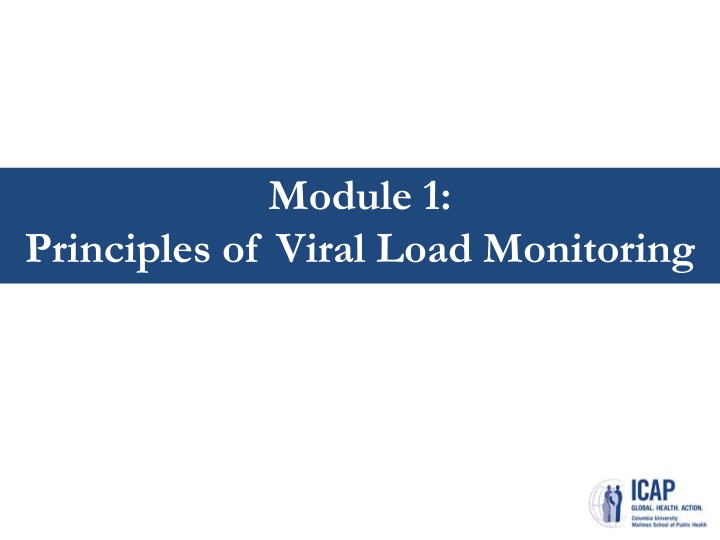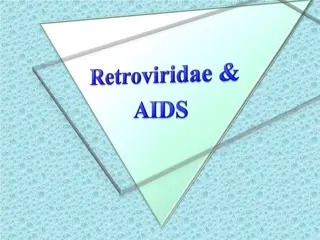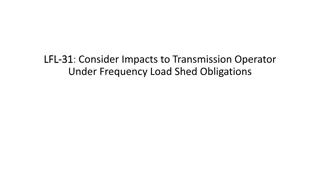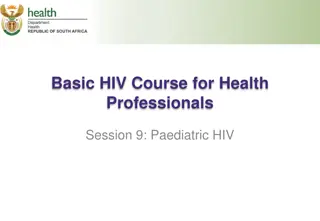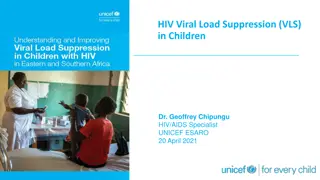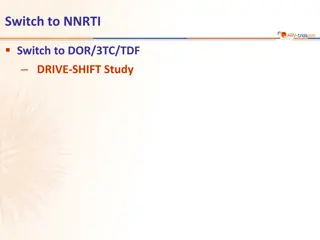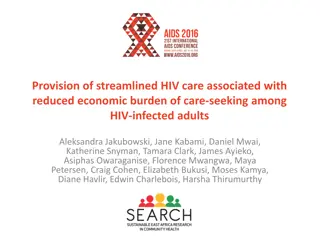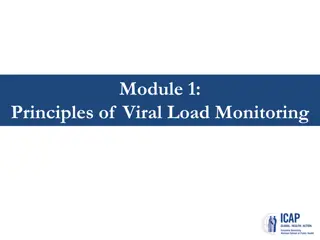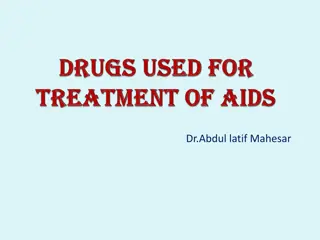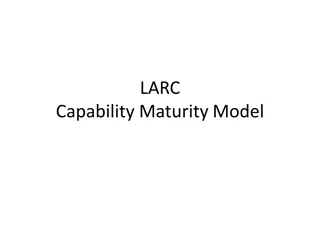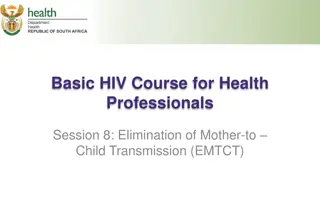Principles of Viral Load Monitoring in HIV Patients
Explore the dynamics of viral load in HIV infection, its impact on transmission and disease progression, response to antiretroviral therapy, identification of treatment failure, and monitoring schedules. Understand the significance of viral load testing in managing HIV patients effectively.
Download Presentation

Please find below an Image/Link to download the presentation.
The content on the website is provided AS IS for your information and personal use only. It may not be sold, licensed, or shared on other websites without obtaining consent from the author.If you encounter any issues during the download, it is possible that the publisher has removed the file from their server.
You are allowed to download the files provided on this website for personal or commercial use, subject to the condition that they are used lawfully. All files are the property of their respective owners.
The content on the website is provided AS IS for your information and personal use only. It may not be sold, licensed, or shared on other websites without obtaining consent from the author.
E N D
Presentation Transcript
Module 1: Principles of Viral Load Monitoring
Learning Objectives Understand the dynamics of viral load during the course of HIV infection Understand how viral load affects risk for transmission and progression of HIV Explain how viral load responds to antiretroviral therapy (ART) Identify treatment failure using viral load Describe schedule of viral load monitoring
Outline Understanding Viral Load Viral Load and HIV Infection Disease Progression Disease Transmission Viral Load Measurement and Reporting Viral Load Response to ART Treatment Failure Criteria Routine and Targeted Viral Load Monitoring Schedule of Viral Load Monitoring
Introduction: What is Viral Load? (1) Viral load is the concentration of HIV RNA copies in blood. This is a reflection of ongoing virus replication in a person s body.
Introduction: What is Viral Load? (2) Viral load is used as an indicator of: Response to ART and risk for clinical disease progression Risk of transmission of HIV between sex partners Risk of transmission of HIV from mother to child Since 2013, WHO guidelines recommend routine viral load testing for all HIV-infected children and adults on ART DHHS Guidelines, 2013; Murray et al, AIDS 1999; Marschner et al, JID 1998; Thiebaut et al, AIDS 2000
Viral Load during HIV Disease Acute infection: Viral load rises rapidly and often to very high levels (>1 million c/ml) 6-12 weeks after infection: Immune response reduces viral load to steady level ( set point ) Set point predicts disease progress, higher set point indicates a more rapid progression to AIDS Without ART, viral load increases over several years, gradually and then more rapidly as symptoms develop www.youngdayschool.edu.uy
Background: VL & HIV transmission Numerous studies have suggested that high viral loads increase HIV transmission within a given community On an individual level, viral load has been shown t o strongly correlate with transmission risk Long known to be the greatest predictor of maternal to child transmission
Viral Load and Sexual Transmission Rate of transmission: 23 per 100 person-years Rate of transmission: 2.2 per 100 person-years Zero transmissions HIV viral load(copies/ml) Quinn et al., NEJM2000
Background: Treatment as Prevention HPTN 052 assessed virologically-linked HIV transmission among stable, healthy serodiscordant couples in which the infected partner had CD4 counts above the ART starting point in effect at the time of the trial All linked HIV transmission events occurred in the early months of treatment, prior to virologicsuppression A linked transmission means that the virus was studied and found to be the same virus No linked HIV transmission events occurred when HIV was stably suppressed by ART in the index participant Cohen,2016
Background: Treatment as Prevention (2) Additional studies (PARTNER 1 and 2 and Opposites Attract) have added additional observations and assessed linked HIV transmissions among MSM No (zero) linked transmissions from HIV-infected individuals who are undetectable VL assays used in these studies had variable upper end cut-off values but all required a VL < 200 copies/ml Rodger 2016; Bavinton 2018; Rodger 2019
UNDETECTABLE = UNTRANSMITTABLE Undetectable means that the amount of HIV in the blood is too low to count on a viral load test Treatment as Prevention (TasP) refers to using antiretroviral therapy (ART) to prevent sexual transmission of HIV U=U is a global movement about how effective treatment as Prevention can be, if scaled widely There is effectively no risk of sexual transmission of HIV when the partner living with HIV has a durably undetectable viral load
UNDETECTABLE = UNTRANSMITTABLE Reduces shame and fear of sexual transmission Dismantles stigma in the community, health care setting, and individually Encourages and motivates people to begin treatment and to be adherent to their treatment Strengthens advocacy efforts for universal access to care
UNDETECTABLE = UNTRANSMITTABLE Caveats Requires implementation of VL testing Requires quantification (VL< 200 copies/ml) Necessitates efficient return of results to the HIV infected individual Requires retesting at regular intervals Requires consistent adherence to maintain viral suppression going forward Places prevention of transmission in the hands of the infected individual This can be both liberating and burdensome
UNDETECTABLE = UNTRANSMITTABLE Caveats Undetectable [or VL < 200 copies/ml if a more sensitive VL assay is used] is the goal to assure that the individual will not transmit HIV via sexual activity This cutoff is distinct [and often different] than the country specific goal for a good clinical response to treatment [a low viral load] which is commonly set at < 1000 copies/ml
Viral Load Measurement Viral load can be measured using whole blood, plasma, or dried blood spots Assays quantify HIV viral load as RNA copies/ml, also reported on a log10 scale Lower limits of detection vary with assays (e.g.<20, 50, 400 copies/ml) Optimal results include target not detected, or the lower limits of detection
Viral Load Log Scale Viral RNA copies/ml of plasma Log-scale: a 1-log change = 10-fold change Viral load changes less than 1 log are generally not of clinicalsignificance Log10scale Copies/ml 1.0 10 1.5 32 2.0 100 2.5 316 3.0 1,000 3.5 3,162 4.0 10,000 4.5 31,623 5.0 100,000 5.5 316,228
Virologic Response to ART ART prevents HIV replication by inhibiting viral enzymes causing the viral load to decline The goal of treatment is to achieve a suppressed viral load: Associated with better clinical outcomes Lower risk of HIV transmission Persistent viral replication while taking ART can lead to resistance to one or more antiretrovirals (ARVs)
Virologic Response to ART Viral load <1000 copies/ml has beenis considered acceptable in many countries Risk of transmission and disease progression is low Regarding clinical endpoints and reduced risk of viral resistance, even lower is better In most patients taking ART, the viral load should be <1000 copies/ml after 6 months of treatment Those with high baseline viral load, such as infants, may take longer to achieve suppression VL target: <1000 copies/ml Better outcome Lower riskof transmission DHHS Guidelines, 2013; Tsibris and Hirsch, PPID 2010; Kaufmann et al., Arch Intern Med 2003
Viral Load Response Country Guidelines Insert country guidelines regarding what is an acceptable VL response to treatment
Immunologic and Clinical Responses to ART with Viral Suppression With viral suppression: CD4 count increases 50 to 150 cells/ l expected in the 1st year 50 to 100 cells/ l expected in the 2nd year Improved clinical status (weight gain, resolution of diarrhea, no new opportunistic infections)
Monitoring for Treatment Failure Treatment failure can be defined using the following criteria: Clinical Immunologic Virologic Resource-limited settings have relied on suboptimal clinical and immunologic methods May not detect early failure Some with clinical or immunologic failure may not actually have virologic failure
How Does Virologic Monitoring Compare to Clinical or Immunologic Monitoring? to Clinical or Immunologic Monitoring? How Does Virologic Monitoring Compare Virologic monitoring has greater sensitivity and positive predictive value for detecting treatment failure than clinical or CD4 criteria. Increased Sensitivity Higher Positive Predictive Value Earlier detection Timely regimen changes Decreased time withongoing viral replication May prevent drug resistance and decrease transmissionrisk Less misclassification Helps prevent unnecessary switches to second-line ART in those who are actually suppressed Kantor et al., CID 2009; Rawizza et al., CID 2011; Mermin et al., BMJ 2011
Viral Load, CD4 and Clinical Criteria for Treatment Failure Viral load (virologic monitoring) is more sensitive and reliable for determining treatment failure for those on ART compared to clinical monitoring or CD4 criteria (immunologic monitoring). www.slideshare.net
Criteria for Treatment Failure Determined by Viral Load Virologic treatment failure: Persistent plasma viral load over the country specific guidelines when measured at least 6 months after starting ART Persistent defined as >2 consecutive viral load results 3 months apart with adherence support between measurements
Routine and Targeted Viral Load Monitoring Routine Viral Load Monitoring Targeted Viral Load Monitoring Ideally, viral load should be measured at regular intervals for all those on ART to monitor response to treatment and for early detection of treatmentfailure In settings where routine viral load is not feasible or available, viral load testing should be used to confirm treatment failure if suspected by CD4 or clinical criteria
WHO 2016 Guidelines: Viral Load Schedule Check viral load 6 months after ART initiation If acceptable, then repeat testing 6 months later, then repeat at least every 12 months If viral load is elevated, provide adherence support and re-check in 3 months Virologic failure only if repeat viral load result is still elevated after adherence support Those with high baseline viral load, such as infants, young children and some adults, may take longer to achieve suppression
Routine and Targeted Viral Load Monitoring Adapted from WHO Guidelines
Adherence Interventions Improve Suppression of Viral Load 53% of those with initial VL >1,000 copies/ml achieved virologic suppression after early viral load testing and a targeted intensive adherence intervention Orrell et al., Antivir Ther2007
Enhanced Adherence Counseling Enhanced Adherence Counseling is a continual and repeated process that involves: Step 1: A structured assessment ofcurrent level ofadherence Step 4: Develop and individualizedadherence interventionplan Step 2: Exploration ofthe specific barriers the patient mustovercome Step 3: Motivatingand assisting patients to identify solutions and address barriers Repeat Steps 1-4 during follow-up sessions.
Achieving Good Adherence Adherence sessions should be repeated until good adherence is achieved Once good adherence is achieved, set a date for repeat viral load measurement after 3 months of good adherence and provide to patient
Viral Load Monitoring: Not Too Much, Not Too Little More evidence is needed to determine the optimal schedule for viral load monitoring. Monitoring too often: Resource intensive, costly and may not contribute to improved patient outcomes If improperly implemented may lead to premature regimen change (e.g. viral load testing prior to expected time of suppression, or repeat viral load testing without improvement in adherence) Infrequent monitoring may lead to late detection of treatment failure, progression of HIV transmission In partially adherent patients delayed viral load testing may allow for emergence of drugresistance disease, or
Schedule for Routine Viral Load Monitoring Adults (Non-Pregnant or Breastfeeding ) Fill in schedule according to national guidelines
Schedule for Routine Viral Load Monitoring Children and Adolescents on ART Fill in schedule according to national guidelines
Schedule for Routine Viral Load Monitoring Pregnant or Breastfeeding Women on ART Fill in schedule according to national guidelines
Role of CD4 Count Tests CD4 test at baseline, when returning to care after a treatment interruption, or when presenting with a new or problem assists in determining the degree of immune suppression CD4 may guide and prioritize workup and assist in decisions about prophylaxis Routine CD4 tests are no longer necessary
CD4 Count Testing Fill in national guidelines on CD4 count testing
Question 1 Which of the following patients has the highest risk of transmitting HIV during an unprotected sexual act? A. On ARVs with VL = 10,000 copies/ml B. Not on ARVs with VL = 100,000 copies/ml C. On ARVs with VL < 20 copies/ml D. On ARVs with VL = 2,000 copies/ml
Answer Which of the following patients has the highest risk of transmitting HIV during an unprotected sexual act? A. On ARVs with VL = 10,000 B. Not on ARVs with VL = 100,000 C. On ARVs with VL < 20 D. On ARVs with VL = 2,000
Question 2 Patient A has a VL = 3,500 after 6 weeks on ART. This represents treatment failure. A. True B. False
Answer Patient A has a VL = 3,500 after 6 weeks on ART. This represents treatment failure. A. True B. False
Question 3 Patient B has an undetectable VL after 6 months on ART. When is the next VL due? 1. Not needed 2. 1 year 3. 6 months 4. 3 months
Answer Patient B has an undetectable VL after 6 months on ART. When is the next VL due? 1. Not needed 2. 1 year 3. 6 months 4. 3 months
Summary Viral load predicts progression of disease in an individual, and onward transmission of HIV to sex partners or from mother tobaby In most individuals, viral load will drop to below levels detectable by viral load blood tests after 6 months of ART Viral load testing is the preferred method for detecting treatment failure for ART patients and should be checked after 6 months on ART Follow country-specific guidelines for the viral load that indicates acceptable response to ART Virologic treatment failure: persistent (>2 viral load tests 3 months apart with adherence support in between ) plasma viral load 1000 copies/ml when measured after at least 6 months of ART
